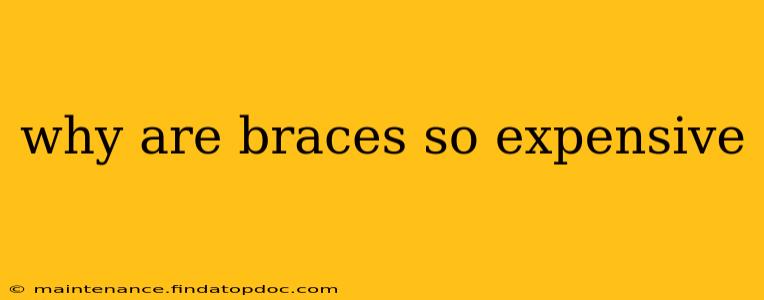Why Are Braces So Expensive? Unpacking the Cost of a Straighter Smile
The high cost of braces is a common concern for many considering orthodontic treatment. While the price tag can certainly be daunting, understanding the factors contributing to the expense can help demystify the process. It's not simply a matter of metal wires and brackets; several key components drive up the overall cost.
What are the main factors contributing to the high cost of braces?
Several interconnected factors influence the final price of orthodontic treatment. Let's break them down:
-
Specialized Professional Expertise: Orthodontists undergo extensive education and training beyond general dentistry, specializing in the complex process of aligning teeth and jaws. This specialized expertise comes with a higher cost of education and, subsequently, professional fees. They are highly skilled professionals investing significant time and resources in their training.
-
Advanced Materials and Technology: Modern orthodontics utilizes advanced materials like high-quality brackets, wires, and other components designed for optimal comfort and effectiveness. These materials are often more expensive than those used in basic dental procedures. Technological advancements, including digital scanning and computer-aided design (CAD) for custom-made aligners, further contribute to the cost.
-
Extensive Treatment Time and Multiple Appointments: Orthodontic treatment is a long-term commitment, typically lasting 18-36 months or more, depending on the complexity of the case. This necessitates numerous appointments, each requiring the orthodontist's time and expertise. Each appointment involves meticulous adjustments, monitoring progress, and addressing any issues that may arise.
-
Laboratory Fees and Overhead Costs: Many components of orthodontic treatment, such as custom-made retainers and appliances, require fabrication in specialized dental labs. These labs incur significant costs for materials, equipment, and skilled technicians. Additionally, the orthodontic practice itself incurs overhead costs, including rent, staffing, insurance, and equipment maintenance, all of which contribute to the final cost passed on to the patient.
-
Complexity of the Case: The complexity of each individual case significantly impacts the overall cost. Simple cases requiring minor adjustments may be less expensive than complex cases involving severe crowding, malocclusion (improper bite), or jaw discrepancies. These complex cases often require more extensive treatment, more time, and potentially more specialized appliances.
What are the different types of braces, and how do their costs vary?
The type of braces you choose can also significantly impact the total cost.
-
Traditional Metal Braces: These are generally the most affordable option, though still relatively expensive. The cost is often lower due to the widespread use and established manufacturing processes.
-
Ceramic Braces: These are aesthetically more appealing as they blend better with the color of teeth, but they're typically more expensive than metal braces due to the cost of materials and the more delicate nature of the brackets.
-
Lingual Braces: These are placed behind the teeth, making them invisible. However, they are generally the most expensive option due to their specialized design, increased complexity in placement and adjustment, and the high level of skill required from the orthodontist.
-
Invisalign (Clear Aligners): Invisalign uses a series of clear plastic aligners to gradually straighten teeth. While potentially more comfortable than traditional braces, they can be more expensive than metal braces, particularly for complex cases. The cost varies depending on the number of aligners needed.
How can I make braces more affordable?
Many options exist to make orthodontic treatment more affordable:
-
Dental Insurance: Check if your dental insurance covers orthodontic treatment, even partially. The coverage amount varies greatly depending on the plan.
-
Payment Plans: Most orthodontists offer payment plans to help spread the cost over the duration of treatment. These plans may involve monthly payments.
-
Financing Options: Third-party financing companies often specialize in providing financing options for dental procedures, including braces.
-
Early Intervention: Starting treatment at a younger age can sometimes reduce the overall treatment time and, therefore, the cost.
The high cost of braces is a significant investment, but the benefits of a healthy and beautiful smile often outweigh the expense for many. By understanding the factors contributing to the cost, you can make an informed decision and explore options for making treatment more accessible.
